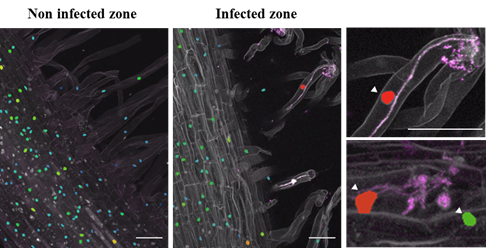A new step towards understanding cytokinin action in symbiotic nodulation
The plant hormone cytokinins regulate many developmental processes and environmental responses, including symbiotic nitrogen-fixing nodulation in legume plants. Cytokinin signalling activation recruits transcription factors called type-B Response Regulators (RRB), and the SILEG team from IPS2, headed by Florian Frugier, recently identified in the Medicago truncatula model legume a core cytokinin signalling module acting in symbiotic nodules and comprising a specific RRB transcription factor named RRB3 (Tan et al., 2019).
In their latest publication in Plant Physiology, Tan et al. (2020) now show that RRB3 is required for infection by symbiotic rhizobia and thus for nodule initiation. They additionally identified two nodulation-related genes directly regulated by RRB3: the essential Nodulation signalling Pathway 2 (NSP2) transcription factor, and the Cell-Cycle Swith 52A (CCS52A) endoreduplication-promoting factor. Interestingly, they additionally show that symbiotic infection events are tightly associated with an increase of nuclear size, which is known to be associated with endoreduplication cell cycles. Overall, these findings bring new clues about how the initiation of symbiotic nitrogen-fixing nodulation in legume plant roots relies on cytokinin signalling.
Figure :

Symbiotic nitrogen-fixing bacteria infections in roots of legume plants are associated with an increase of the size of nuclei.
Symbiotic infections appear as infection threads, and nuclei are colored in relation to their size (in red, maximum size observed)
